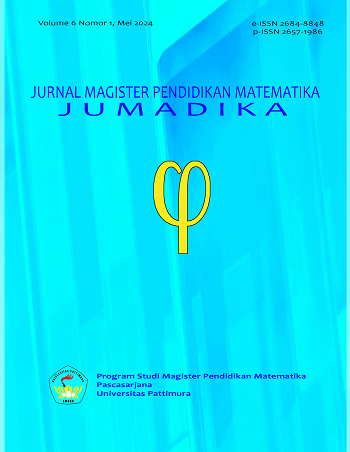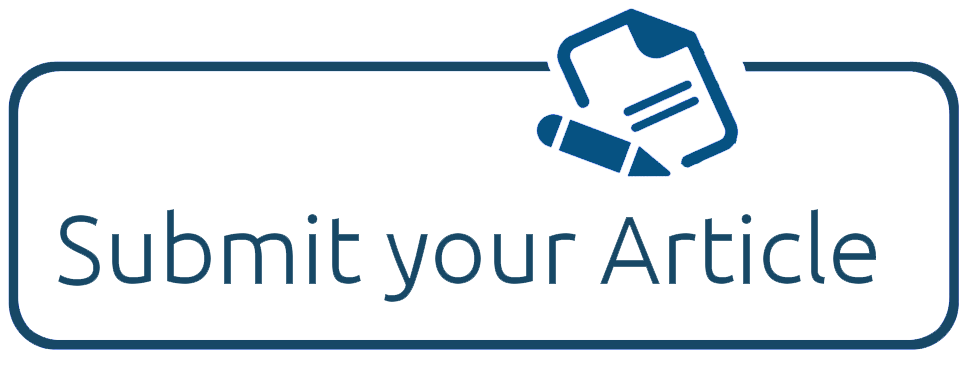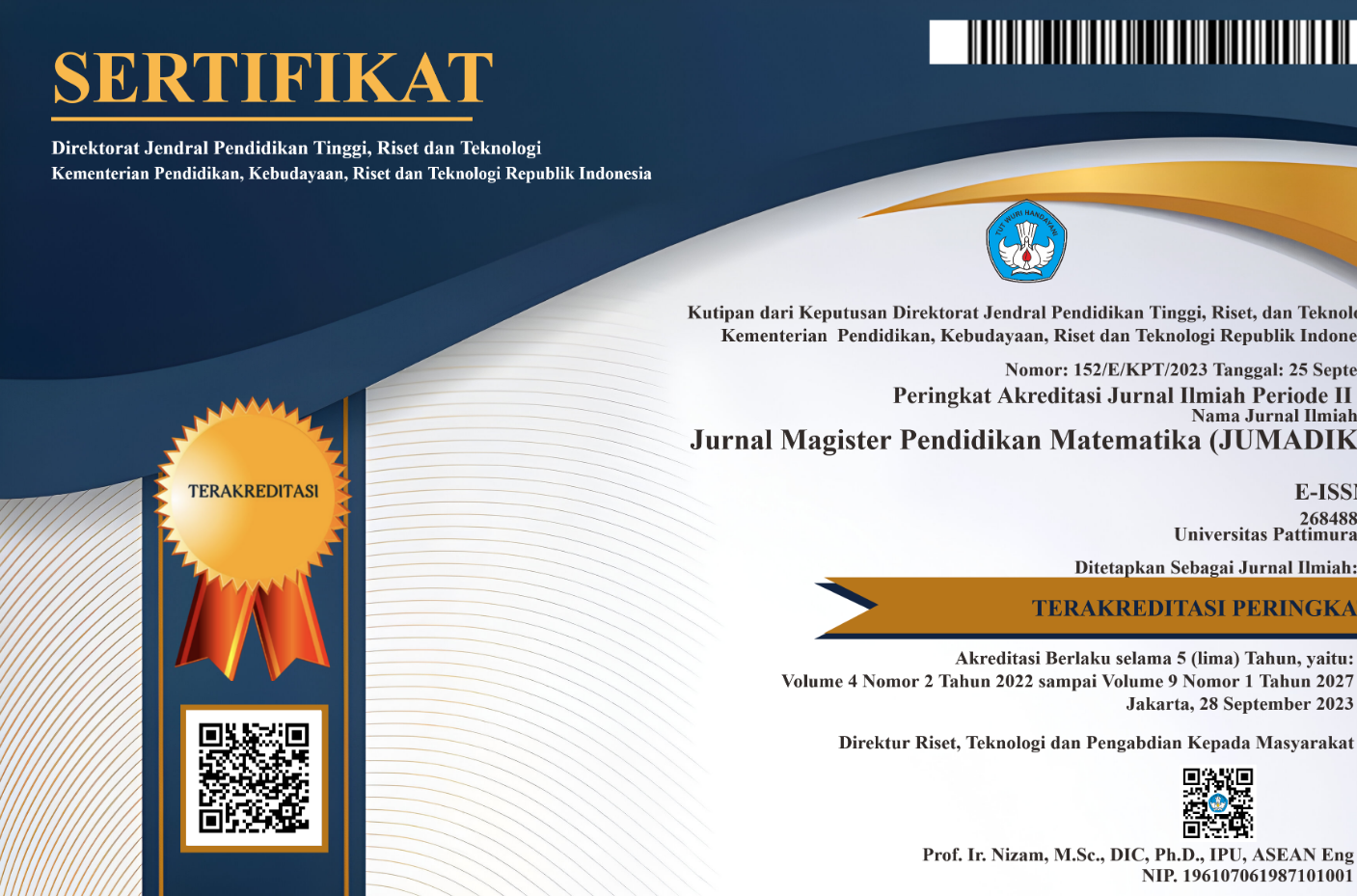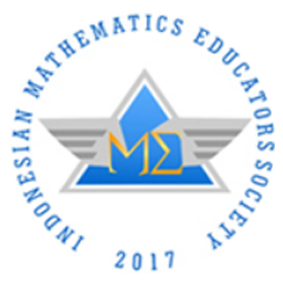DEVELOPING TEACHING AIDS BASED ON WINGEOM SOFTWARE USING TUMBUR SCULPTURE ON LINE AND ANGLE MATERIALS AT CLASS VII OF SMP
Abstract
Mathematics is considered difficult because it has several characteristics, one of which is the study of abstract objects which causes most students to experience difficulties. The results of interviews and initial observations at one of the junior high schools in Saumlaki found that students' ability to solve mathematical problems was very low as evidenced by students' ability tests on lines and angles with a total of 26 students, with 27% of students completing it and 73. % of students who did not complete. What is the process of developing valid, practical and effective RPP, BA and LKPD tools using the context of tumbur statues by utilizing wingeom as a learning medium on lines and angles? The aim is to determine the level of validity, practicality and effectiveness of RPP, BA and LKPD as learning tools using the context of tumbur and wingeom statues as learning media on lines and angles. This research includes Research and Development research with a 4-D model approach. The development of RPP, BA and LKPD which have been validated by each validator is declared "Valid". The RPP, BA and LKPD developed were declared to meet practicality as the response to the RPP, BA and LKPD was in the "Very Good" category, the implementation of the RPP, BA and LKPD tools in the learning process was in the "Completely Implemented" category. The RPP, BA and LKPD were declared effective, as there were two aspects achieved, namely the effectiveness of the time used in accordance with the design and the student learning outcomes test which achieved classical completeness as many as 19 students and 79.2% were declared complete based on the KKM
Downloads
References
Anderha, R. R., & Maskar, S. (2021). Pengaruh Kemampuan Numerasi Dalam Menyelesaikan Masalah Matematika Terhadap Prestasi Belajar Mahasiswa Pendidikan Matematika. Jurnal Ilmiah Matematika Realistik (JI-MR), 2(1), 1-10.
Dasmasela, J., Urath, S., & Nifanngelyau, J. (2021). Etnomatematika Seni Rupa Patung Tumbur. Jurnal Pendidikan Indonesia, 2(1), 36-47.
Fitria, A. D., Mustami, M. K., & Taufiq, A. U. (2017). Pengembangan media gambar berbasis potensi lokal pada pembelajaran materi keanekaragaman hayati di kelas x di sma 1 pitu riase kab. Sidrap. AULADUNA: Jurnal Pendidikan Dasar Islam, 4(2), 14-28.
Fonna, M., & Mursalin. (2018). Pengembangan Modul Geometri Analitik Bidang Berbantuan Wingeom Software untuk Meningkatkan Kemampuan Representasi Matematis Mahasiswa Program Studi Pendidikan Matematika Universitas Malikussaleh. Proceeding Seminar Nasional Politeknik Negeri Lhokseumawe, 1, (1).
Hidayat, F., & Lestari, P. (2022). Kemampuan Representasi Matematis Siswa Berbantuan Aplikasi Wingeom pada Masa Pembelajaran Tatap Muka Terbatas. Plusminus: Jurnal Pendidikan Matematika, 2(3), 509-520.
Irmawati M. (2019). Pengembangan Perangkat Pembelajaran Matematika Menggunakan Metode Discovery Learning Berbasis GRANDER di Sekolah Dasar. In Tesis. Makasar: Universitas Muhamadiah Makasar.
Irmawati M; Rukli; Baharullah. (2019). Pengembangan Perangkat Pembelajaran Matematika Menggunakan Metode Discovery LearningBerbasis GRANDER di Sekolah Dasar. Edumaspul: Jurnal Pendidikan, 3(2), 127-139.
Munawarah. (2017). Pengembangan Perangkat Pembelajaran Matematika Dengan Menggunakan Pendekatan Kontekstual. Jurnal Matematika dan Pembelajaran, 5(2), 168-186.
Nurmaya, Y., Susilawati, Zuhdi, M., & Hikmawati. (2021). Pengembangan Perangkat Pembelajaran Model Inkuiri Terbimbing Pada Materi Alat-Alat Optik Untuk Meningkatkan Penguasaan Konsep Fisika. Jurnal Hasil Kajian, Inovasi, dan Aplikasi Pendidikan Fisika, 7(1), 147-154.
Pinahayu, E. R., Auliya, R. N., & Adnyani, L. W. (2018). Implementasi Aplikasi Wingeom Untuk Pengembangan Bahan Di SMP. Jurnal PKM: Pengabdian kepada Masyarakat, 01(02), 112-121.
Ratumanan, T. G., & Laurens, T. (2016). Analisis penguasaan objek matematika (Kajian pada lulusan SMA di Provinsi Maluku). Jurnal Pendidikan Matematika Raflesia, 1(2), 146-154.
Salaka, C., Molle, J. S., & Gaspersz, M. (2022). Penerapan Model Pembelajaran Kooperatif Tipe Think Talk Write Untuk Meningkatkan Hasil Belajar Siswa Pada Materi Sistem Persamaan Linier Tiga Variabel. Jurnal Pendidikan MatematikaUnpatti, 3(2), 66-70.
Sutrisno, A. B., & Atira. (2020). Keefektifan Penggunaan Aplikasi Wingeom Dalam Pemaparan Materi Pelajaran Dimensi Tiga. de Fermat : Jurnal Pendidikan Matematika, 3(1), 37-45.
Wafiyah, A. N. (2021). Pengembangan Media Pembelajaran Box Diamond Materi Pengelolahan Data Dalam Peningkatan Hasil Belajar Di Madrasah Ibtidayah Malang. In Tesis. Malang: Universitas Islam Negeri Maulana Malik Ibrahim.
Wulandari, N. R., Dantes, N., & Antara, P. A. (2020). Pendekatan Pendidikan Matematika Realistik Berbasis Open EndedTerhadap Kemampuan Pemecahan Masalah Matematika Siswa. Jurnal Ilmiah Sekolah Dasar, 4(2), 131-142.
Copyright (c) 2024 Jakobus Dasmasela, Theresia Laurens, Carolina Selfisina Ayal

This work is licensed under a Creative Commons Attribution-NonCommercial-ShareAlike 4.0 International License.
License and Copyright Agreement
In submitting the manuscript to the journal, the authors certify that:
- They are authorized by their co-authors to enter into these arrangements.
- The work described has not been formally published before, except in the form of an abstract or as part of a published lecture, review, thesis, or overlay journal. Please also carefully read Jurnal Magister Pendidikan Matematika (JUMADIKA) Posting Your Article Policy.
- That it is not under consideration for publication elsewhere,
- That its publication has been approved by all the author(s) and by the responsible authorities – tacitly or explicitly – of the institutes where the work has been carried out.
- They secure the right to reproduce any material that has already been published or copyrighted elsewhere.
- They agree to the following license and copyright agreement.
Copyright
Authors who publish with Jurnal Magister Pendidikan Matematika (JUMADIKA) agree to the following terms:
- Authors retain copyright and grant the journal right of first publication with the work simultaneously licensed under a Creative Commons Attribution-NonCommercial-ShareAlike 4.0 International License (http://creativecommons.org/licenses/by-nc-sa/4.0/) that allows others to share the work with an acknowledgment of the work's authorship and initial publication in this journal.
- Authors are able to enter into separate, additional contractual arrangements for the non-exclusive distribution of the journal's published version of the work (e.g., post it to an institutional repository or publish it in a book), with an acknowledgment of its initial publication in this journal.
- Authors are permitted and encouraged to post their work online (e.g., in institutional repositories or on their website) prior to and during the submission process, as it can lead to productive exchanges, as well as earlier and greater citation of published work.








